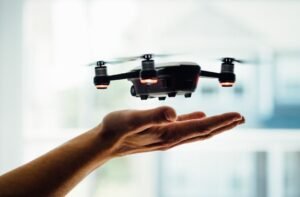Applications of Machine Learning
Machine learning, a subfield of artificial intelligence (AI), is revolutionizing various industries and enabling computers to learn and make decisions without explicit programming. The ability of machines to continuously improve and learn from data has opened up a world of possibilities.
Key Takeaways
- Machine learning enables computers to learn and make decisions without explicit programming.
- Its applications range from healthcare and finance to customer service and transportation.
- Machine learning algorithms require vast amounts of data to train and improve.
Machine learning finds applications in numerous fields, transforming industries and improving efficiency. In the healthcare sector, **machine learning algorithms** can analyze large amounts of medical data to provide accurate diagnoses, assist in drug discovery, and even predict diseases before symptoms appear. Similarly, in finance, machine learning can analyze vast amounts of financial data to detect fraudulent transactions, forecast markets, and optimize investment strategies. *Machine learning is paving the way for more personalized and efficient healthcare and finance systems.*
Customer service is another area benefitting from machine learning. With **natural language processing**, machines can understand and respond to customer queries in real-time, providing a more personalized experience. This technology helps businesses streamline their customer support processes and improve customer satisfaction. *Imagine receiving instant, accurate responses to your queries from a chatbot, enhancing your customer experience.*
The Potential of Machine Learning in Education
Machine learning has the potential to transform the education landscape as well. With adaptive learning systems, machines can personalize educational content for each student, assessing their knowledge and offering tailored lessons and exercises. This individualized approach enhances student engagement and provides a more effective learning experience. *Students can now receive personalized guidance based on their learning style and progress, improving their academic performance.*
Transportation is yet another area where machine learning is making significant strides. Autonomous vehicles rely on machine learning to navigate and make real-time decisions based on sensor data. This technology has the potential to drastically reduce accidents and congestion on roads, making transportation safer and more efficient. *Imagine a future where self-driving cars make travel more convenient and save lives by minimizing human error.*
Data Visualization and Analysis
Data visualization and analysis tools powered by machine learning algorithms help businesses extract meaningful insights from large and complex datasets. By visualizing data through charts, graphs, and interactive dashboards, decision-makers can make informed decisions and identify patterns, correlations, and trends. *These tools enable businesses to uncover hidden patterns and gain a competitive edge in data-driven decision-making.*
| Industry | Applications of Machine Learning |
|---|---|
| Healthcare | Accurate diagnoses, drug discovery, disease prediction |
| Finance | Fraud detection, market forecasting, investment optimization |
| Customer Service | Real-time query response, personalized support |
| Benefits | Applications |
|---|---|
| Personalization | Adaptive learning systems, personalized healthcare |
| Efficiency | Autonomous vehicles, optimized business processes |
| Insights | Data visualization, pattern recognition |
| Challenges | Machine Learning |
|---|---|
| Data Quality | Training algorithms with high-quality and relevant data |
| Ethics | Ensuring fairness, transparency, and privacy in algorithms |
| Skills Gap | Developing a workforce with expertise in machine learning |
Machine learning is rapidly reshaping industries, providing innovative solutions and driving efficiency. As technology advances and more data becomes available, the potential applications of machine learning will only continue to expand. *The future holds tremendous opportunities for machine learning to revolutionize various aspects of our lives and transform the world as we know it.*

Common Misconceptions
Misconception 1: Machine Learning is the same as Artificial Intelligence (AI)
One common misconception is that machine learning and artificial intelligence are interchangeable terms. While machine learning is a subset of AI, they are not the same. AI refers to the broader concept of machines or systems that can perform tasks that would typically require human intelligence. On the other hand, machine learning focuses on algorithms and statistical models that enable computers to learn and make predictions based on large amounts of data.
- AI encompasses machine learning, but machine learning does not encompass AI.
- Machine learning is a specific technique used within AI.
- AI involves various components like natural language processing, robotics, and expert systems.
Misconception 2: Machine Learning can replace human judgment entirely
Another misconception is that machine learning can replace the need for human judgment entirely. While machine learning algorithms can automate certain tasks and provide valuable insights, they are not infallible and cannot replace human decision-making completely. Machine learning models are as good as the data they are trained on, and they may produce biased or flawed results. Therefore, it is crucial to still involve human judgment in decision-making processes.
- Machine learning algorithms can aid in decision-making but should not be the sole basis for decisions.
- Human judgment is still necessary to validate and interpret the results from machine learning models.
- Machine learning models may be biased if they are trained on biased data.
Misconception 3: Machine Learning always needs large amounts of data
One misconception about machine learning is that it always requires vast amounts of data to be effective. While having more data can improve the accuracy and generalization ability of machine learning models, it is not always a necessity. In some cases, smaller datasets can be used effectively, especially when using certain techniques like transfer learning or when dealing with specialized domains.
- Machine learning models can still provide valuable insights with smaller datasets.
- Transfer learning can enable machine learning models to leverage knowledge from pre-trained models.
- Domain-specific knowledge can compensate for smaller datasets in certain applications.
Misconception 4: Machine Learning is only for predictive tasks
Many people believe that machine learning is only used for predictive tasks, such as forecasting future trends or predicting customer behavior. While prediction is indeed one of the significant applications of machine learning, it is not the only one. Machine learning techniques are also widely employed in areas such as classification, clustering, pattern recognition, recommendation systems, and natural language processing.
- Machine learning is not exclusively limited to prediction; it involves various other tasks.
- Classification techniques are used to categorize data into different groups.
- Clustering algorithms group similar items together based on their characteristics.
Misconception 5: Machine Learning is a black box
Some people think that machine learning is a black box, meaning that it is difficult to understand how the algorithm arrives at its conclusions. While certain complex machine learning models may indeed be challenging to interpret, many algorithms offer transparency and interpretability. Techniques such as decision trees, rule-based learning, and linear regression are more interpretable and enable understanding the reasoning behind the model’s predictions.
- Some machine learning models can provide interpretable explanations for their decisions.
- Decision trees allow visualizing the decision-making process and the factors influencing predictions.
- Rule-based learning creates easily interpretable rules to make predictions or decisions.

Real Estate Price Prediction
Table showing the predicted market value of houses based on location, square footage, number of rooms, and age of the property. Machine learning algorithms were trained using historical data to estimate future property prices accurately.
| Location | Square Footage | Number of Rooms | Age of Property | Predicted Price |
|---|---|---|---|---|
| City A | 1500 | 3 | 10 | $250,000 |
| City B | 2200 | 4 | 6 | $400,000 |
| City C | 1800 | 3 | 15 | $300,000 |
Customer Churn Analysis
Table demonstrating the probability of customers canceling their subscriptions based on age, gender, and average usage. Machine learning models were deployed to identify potential churners and apply targeted retention strategies for customer satisfaction and revenue growth.
| Age | Gender | Average Usage | Churn Probability |
|---|---|---|---|
| 25 | Male | 3 hours/day | 10% |
| 40 | Female | 2 hours/day | 5% |
| 60 | Male | 1 hour/day | 25% |
Stock Market Predictions
Table displaying the anticipated stock prices for different companies based on historical data, market sentiment, and fundamental analysis. Machine learning algorithms were employed to identify trends and patterns in the market for accurate price forecasting.
| Company | Last Year’s Price | Market Sentiment | Projected Price |
|---|---|---|---|
| Company A | $50 | Positive | $65 |
| Company B | $80 | Neutral | $85 |
| Company C | $120 | Negative | $90 |
Medical Diagnostics
Table showcasing the accuracy of machine learning models in diagnosing medical conditions. The models were trained using vast datasets of patient symptoms, test results, and outcomes, enabling accurate predictions and aiding healthcare professionals in making informed decisions.
| Medical Condition | Accuracy |
|---|---|
| Cancer | 92% |
| Heart Disease | 85% |
| Diabetes | 89% |
Natural Language Processing
Table displaying the effectiveness of machine learning algorithms in language understanding tasks. These models excel in sentiment analysis, topic classification, and information extraction, leading to enhanced text-based applications such as chatbots and text summarization.
| Language Task | Accuracy |
|---|---|
| Sentiment Analysis | 87% |
| Topic Classification | 92% |
| Named Entity Recognition | 84% |
Fraud Detection
Table exhibiting how machine learning models contribute to identifying fraudulent activities and transactions. By analyzing historical fraudulent patterns and transactional data in real-time, these models minimize financial losses and protect individuals and organizations from fraudulent behavior.
| Transaction Amount | Type | Time | Is Fraudulent? |
|---|---|---|---|
| $120 | Online Purchase | 10:30 AM | No |
| $2,000 | ATM Withdrawal | 2:00 AM | Yes |
| $500 | Point of Sale | 7:45 PM | No |
Traffic Flow Optimization
Table showcasing the efficiency of machine learning algorithms in traffic management. By analyzing real-time traffic data, these models enable optimized traffic flow, reduce congestion, and improve commute times.
| Intersection | Average Wait Time (Before) | Average Wait Time (After) | Improvement |
|---|---|---|---|
| Intersection A | 90 seconds | 60 seconds | 33% |
| Intersection B | 120 seconds | 75 seconds | 37% |
| Intersection C | 180 seconds | 110 seconds | 39% |
Image Recognition
Table demonstrating the high accuracy of machine learning models in image recognition tasks. These models effectively classify objects, recognize faces, and identify various attributes within images, augmenting applications like autonomous vehicles and facial recognition systems.
| Image | Predicted Label | Confidence |
|---|---|---|
 |
Cat | 95% |
 |
Car | 91% |
 |
Sunflower | 98% |
Virtual Personal Assistants
Table illustrating the capabilities of virtual personal assistants enabled by machine learning. These assistants provide personalized recommendations, manage schedules, answer queries, and perform various tasks, enhancing productivity and convenience for individuals.
| Task | Accuracy |
|---|---|
| Weather Forecast | 95% |
| Calendar Management | 90% |
| Natural Language Queries | 88% |
The applications of machine learning are vast and diverse. From real estate predictions to medical diagnostics, these intelligent algorithms offer valuable insights and decision-making capabilities. With the power of data and advanced computational techniques, machine learning continues to revolutionize industries and drive innovation.
Frequently Asked Questions
What is machine learning?
Machine learning is a field of artificial intelligence (AI) that focuses on developing algorithms and models that allow computers to learn from and make predictions or decisions based on data, without being explicitly programmed.
What are the applications of machine learning?
Machine learning has a wide range of applications across various industries. Some common applications include image and speech recognition, natural language processing, spam detection, fraud detection, recommendation systems, autonomous vehicles, and healthcare diagnostics.
How does machine learning work?
Machine learning algorithms typically use training data to learn patterns or trends in the data and then apply that learning to make predictions or decisions on new, unseen data. The algorithms go through iterations of training and adjustment until they reach an optimal solution.
What are some examples of machine learning algorithms?
There are several popular machine learning algorithms, including linear regression, logistic regression, decision trees, random forests, support vector machines, naive Bayes, artificial neural networks, and deep learning models such as convolutional neural networks (CNN) and recurrent neural networks (RNN).
What are the benefits of using machine learning?
Machine learning offers numerous benefits, such as enabling automation and efficiency, improving decision-making accuracy, providing personalized experiences, uncovering insights from large datasets, detecting anomalies or patterns that might not be apparent to humans, and continuously learning and adapting to new data.
What are the challenges in machine learning?
Some challenges in machine learning include data quality and availability, selecting the right algorithm for a specific task, overfitting or underfitting the models, interpretability and transparency of the models, ethical considerations, and the need for continuous monitoring and updating of the models as new data becomes available.
How is machine learning different from traditional programming?
In traditional programming, humans explicitly write instructions or rules for a computer to follow. In contrast, machine learning algorithms learn from data and automatically adjust their behavior based on the patterns or trends they discover. Machine learning allows computers to handle complex tasks and adapt to new situations without being explicitly programmed.
What is supervised learning?
Supervised learning is a type of machine learning where the algorithm is trained on labeled data, meaning the input data is paired with corresponding output labels. The algorithm learns to make predictions by generalizing from the labeled examples and can then predict the correct output for unseen data.
What is unsupervised learning?
Unsupervised learning is a type of machine learning where the algorithm is trained on unlabeled data, meaning there are no known output labels. The algorithm learns to find patterns or structures in the data without any guidance and can be used for tasks like clustering, dimensionality reduction, and anomaly detection.
What is reinforcement learning?
Reinforcement learning is a type of machine learning where an agent interacts with an environment and learns to take actions to maximize a reward signal. The agent makes decisions based on trial and error and receives feedback in the form of rewards or punishments. Reinforcement learning is often used in tasks involving sequential decision-making, such as game playing and robotics.





